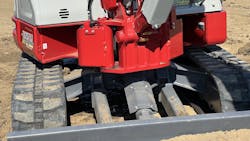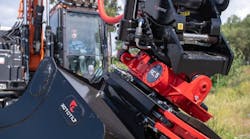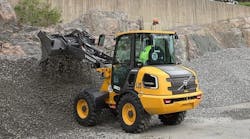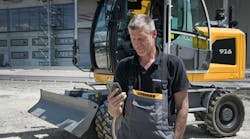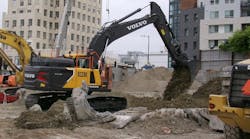Ubiquitous on mini-excavators, dozer blades for backfilling and grading have crept up to the medium 20,000- to 40,000-pound excavator size class.
As in other machine categories, operators have been asking for increased versatility, hence the blade option.
Dozer blades on excavators have also proven popular in numerous Construction Equipment Field Tests, as IUOE independent operator/instructors have used them not only to backfill and grade, but to manipulate objects like rocks to position them for a bucket or a thumb attachment.
“In some applications when you’ve got the blade in front of you, it’s nice to be able to actually use that and grab rock, or slag, or other material to force them into the smaller buckets,” said IUOE Local 150 operator/instructor Chad Jeffries.
Read also: Operators Test Wacker Neuson ET58 Performance
There is also the desire to use a blade to enhance positioning and performance in tight spaces.
“Connecting to the base of the chassis of the excavator, not the boom, excavators are able to grade just as well as skid steers, CTLs, and bulldozers,” said Kevin Forestell, CEO of DOZR, an online equipment rental company.
“While other machines often require you to be in close proximity to whatever you're moving and grading, mini excavators have the unique capability of moving soil or material to the front of the excavator and then using the blade accordingly,” Forestell said. “This can make them better options for when areas might be tight or hard to maneuver.
“Mini excavator blade attachments are great customizations that allow you to create slopes, grade land, and dig around objects that might already exist like sewer lines or tree roots,” Forestell said. “The tilt function of the excavator's thumb also allows you to use these blades in ways that other types of machinery are not able to utilize the blade. Other jobs that blade attachments for mini excavators can simplify are backfilling trenches, leveling terrain, shaping drainage swales, and more.”
According to the equipment experts at Monster Tires, excavator blades must be positioned correctly to operate the mini excavator. The mini excavator is designed to let the operator know when the blade is not positioned correctly to keep the operator safe and the machine from tipping over.
When digging, Monster said, keep the blade in the back and on the ground. This positioning pins the mini excavator to the ground and stabilizes it.
When moving the mini excavator on rough ground or a slope, the blade needs to be in the back and lifted slightly off the ground; if the slope is too tall, the blade will hit the ground to let you know that you need to either reposition the arm linkage down in front or that the slope is just too tall.
Here is a sampling of offerings from some major manufacturers, skewed toward the largest machines in the 20,000- to 40,000-pound category offering blades.
Komatsu’s PC138USLC-11 is equipped for easy field installation of a wide 8-foot 6-inch blade.
The Cat 315 is a 34,000-pound unit that offers a blade, as does the 30,400-pound 313. Cat’s angle dozer blade option is designed to optimize machine flexibility in backfilling and finish grading applications.
In addition to offering ample above- and below-grade travel with standard float function for easy clean-up, the angle blade moves 45 degrees left or right of center. Meant to increase efficiencies and reduce operator interaction with final grading, angle blade movement is controlled by the right-hand joystick, while the left joystick handles machine drive.
Volvo's EC145E has an operating weight that ranges from 31,770 to 36,790 pounds. The blade option for the unit raises to 1 foot 11 inches and has a dig depth of two feet.
Read also: How to Safely Operate an Excavator
"The blade option on this medium excavator simply allows customers to do more," said Sejong Ko, excavator project manager at Volvo CE North America. "They can backfill as well as grade, and they can use the blade to help stabilize the excavator. They can also do more manuevering in close quarters."
Bobcat’s almost 35,000-pound E145 has an optional blade while the larger E165, at over 38,000 pounds, does not offer one.
One of Hitachi’s heaviest units with a blade is the ZX135US-7, a 31,973-pound machine.
John Deere's 135 P-Tier, checking in at 31,526 to 33,951 pounds, has an optional blade with an 18-inch lift height, and a lift angle of 28.5 degrees. It cuts 21 inches below grade. The blade itself is 8 feet 3 inches long and 18 inches high.
What looks to be the king of excavator dozer blades is on KOBELCO's ED160BR-7 Blade Runner excavator. It has a six-way, Power, Angle, Tilt (PAT) blade. Operated by a single control lever, the blade can be angled 27 degrees to the left or right. It also tilts up on the left and right sides by 17.5 inches for slope grading, culverts, and ditches.
The dozer blade has a 10-foot 8-inch width and a 31.9-inch height. The working ranges are 31.1 inches (height) and 23.6 inches (depth). Blade capacity is 2.1 cubic yards. The blade’s drawbar pulling force is 43,800 lb.-ft.
The dedicated dozer circuit has a relief valve setting of 3,970 psi, so it is unaffected by digging, swinging, travel, or other machine functions, according to the company.
Another option is to add a blade attachment from a third-party manufacturer to the excavator. These can take the form of a traditional blade, or a “beam” that attaches to the excavator’s bucket.
An excavator grading beam is an attachments designed to grade in much the same way a skid steer using a bucket. The main difference is that an excavator grading beam is far more precise, said attachment provider Skid Steers Direct.
The grading beam attaches to the end of the excavators arm. It is designed to be wide and flat to give both a large working width and great visibility.
On the cab side of the beam, there is an opening to give it a bucket type of design. The bucket side has a cutting edge on the bottom and works to scoop, scrap, and carry material. The back of the beam is flat and works as a surface to push material.

